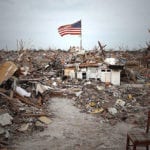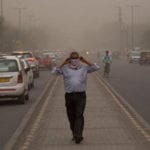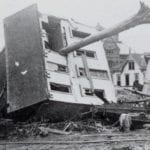 Mysteries
Mysteries  Mysteries
Mysteries  History
History 10 Surprising Stories About the Texas Rangers
 Humans
Humans 10 Philosophers Who Were Driven Mad by Their Own Theories
 Miscellaneous
Miscellaneous 10 Video-Game-Worthy Weapons and Armors from History
 Weird Stuff
Weird Stuff 10 Psychics Who Accurately Predicted Wartime Events
 The Arts
The Arts 10 Pieces of Art Inspired by a Broken Heart
 Health
Health 10 Science Fiction-Sounding New Medical Treatments
 History
History 10 Surprising Facts About the Father of Submarine Warfare
 Space
Space Ten Astonishing New Insights into Alien Worlds
 Weird Stuff
Weird Stuff 10 Bizarre Summer Solstice Rituals Still Practiced Today
 Mysteries
Mysteries Top 10 Haunting Facts About the Ghost Ship MV Alta
 History
History 10 Surprising Stories About the Texas Rangers
 Humans
Humans 10 Philosophers Who Were Driven Mad by Their Own Theories
Who's Behind Listverse?

Jamie Frater
Head Editor
Jamie founded Listverse due to an insatiable desire to share fascinating, obscure, and bizarre facts. He has been a guest speaker on numerous national radio and television stations and is a five time published author.
More About Us Miscellaneous
Miscellaneous 10 Video-Game-Worthy Weapons and Armors from History
 Weird Stuff
Weird Stuff 10 Psychics Who Accurately Predicted Wartime Events
 The Arts
The Arts 10 Pieces of Art Inspired by a Broken Heart
 Health
Health 10 Science Fiction-Sounding New Medical Treatments
 History
History 10 Surprising Facts About the Father of Submarine Warfare
 Space
Space Ten Astonishing New Insights into Alien Worlds
 Weird Stuff
Weird Stuff 10 Bizarre Summer Solstice Rituals Still Practiced Today
Top 10 Bizarre Disasters
Through history, there have been some dreadful disasters leading to enormous numbers of deaths. There have also been a number of disasters that were just outright weird. This is a list of those ten most bizarre disasters.
10The St. Pierre Snake Invasion
Volcanic activity on the ‘bald mountain’ towering over St Pierre, Martinique, was usually so inconsequential that no one took seriously the fresh steaming vent-holes and earth tremors during April, 1902. By early May, however, ash began to rain down continuously, and the nauseating stench of sulphur filled the air. Their homes on the mountainside made uninhabitable, more than 100 fer-de-lance snakes slithered down and invaded the mulatto quarter of St Pierre. The 6-ft long serpents killed 50 people and innumerable animals before they were finally destroyed by the town’s giant street cats. But the annihilation had only begun. On May 5, a landslide of boiling mud spilled into the sea, followed by a tsunami that killed hundreds and, three days later, May 8, Mt Pelee finally exploded, sending a murderous avalanche of white-hot lava straight toward the town. Within three minutes St Pierre was completely obliterated. Of its 30,000 population, there were only two survivors.
Disaster from the skies! Find out how the planet wants you dead in the captivating book Bizarre Weather at Amazon.com!
9The Shiloh Baptist Church Panic
Two thousand people, mostly black, jammed into the Shiloh Baptist Church in Birmingham, Alabama, on September 19, 1902, to hear an address by Booker T. Washington. The brick church was new. A steep flight of stairs, enclosed in brick, led from the entrance doors to the church proper. After Washington’s speech, there was an altercation over an unoccupied seat, and the word ‘fight’ was misunderstood as ‘fire’. The congregation rose as if on cue and stampeded for the stairs. Those who reached them first were pushed from behind and fell. Others fell on top of them until the entrance was completely blocked by a pile of screaming humanity 10 ft high. Efforts by Washington and the churchmen down in the front to induce calm were fruitless, and they stood by helplessly while their brothers and sisters, mostly the latter, were trampled or suffocated to death. There was neither fire – nor even a real fight – but 115 people died.
8 The Great Boston Molasses Flood
On January 15, 1919, the workers and residents of Boston’s North End, mostly Irish and Italian, were out enjoying the noontime sun of an unseasonably warm day. Suddenly, with only a low rumble of warning, the huge cast-iron tank of the Purity Distilling Company burst open and a great wave of raw black molasses, two storeys high, poured down Commercial Street and oozed into the adjacent waterfront area. Neither pedestrians nor horse-drawn wagons could outrun it. Two million gallons of molasses, originally destined for rum, engulfed scores of people – 21 men, women and children died of drowning or suffocation, while another 150 were injured. Buildings crumbled, and an elevated train track collapsed. Those horses not completely swallowed up were so trapped in the goo they had to be shot by the police. Sightseers who came to see the chaos couldn’t help but walk in the molasses. On their way home they spread the sticky substance throughout the city. Boston smelled of molasses for a week, and the harbour ran brown until summer.
7 The Pittsburg Gasometer Explosion
A huge cylindrical gasometer – the largest in the world at that time – located in the heart of the industrial centre of Pittsburgh, Pennsylvania, developed a leak. On the morning of November 14, 1927, repairmen set out to look for it – with an open-flame blowlamp. At about 10 o’clock they apparently found the leak. The tank, containing 5 million cu. ft of natural gas, rose in the air like a balloon and exploded. Chunks of metal, some weighing more than 100 lbs, were scattered great distances, and the combined effects of air pressure and fire left a square mile of devastation. Twenty-eight people were killed and hundreds were injured.
6 The Gillingham Fire Demonstration
Every year the firemen of Gillingham, in Kent, England, would construct a makeshift ‘house’ out of wood and canvas for the popular fire-fighting demonstration at the annual Gillingham Park fête. Every year, too, a few local boys were selected from many aspirants to take part in the charade. On July 11, 1929, nine boys – aged 10 to 14 – and six firemen costumed as if for a wedding party, climbed to the third floor of the ‘house’. The plan was to light a smoke fire on the first floor, rescue the ‘wedding party’ with ropes and ladders, and then set the empty house ablaze to demonstrate the use of the fire hoses. By some error, the real fire was lit first. The spectators, assuming the bodies they saw burning were dummies, cheered and clapped, while the firemen outside directed streams of water on what they knew to be a real catastrophe. All 15 people inside the house died.
5 The Empire State Building Crash
On Saturday morning, July 28, 1945, a veteran Army pilot took off in a B-25 light bomber from Bedford, Massachusetts, headed for Newark, New Jersey, the co-pilot and a young sailor hitching a ride were also aboard. Fog made visibility poor. About an hour later, people on the streets of midtown Manhattan became aware of the rapidly increasing roar of a plane and watched with horror as a bomber suddenly appeared out of the clouds, dodged between skyscrapers, and then plunged into the side of the Empire State Building. Pieces of plane and building fell like hail. A gaping hole was gouged in the 78th floor, one of the plane’s two engines hurtled through seven walls and came out the opposite side of the building, and the other engine shot through an elevator shaft, severing the cables and sending the car plummeting to the basement. When the plane’s fuel tank exploded, six floors were engulfed in flame, and burning gasoline streamed down the sides of the building. Fortunately, few offices were open on a Saturday, and only 11 people – plus the three occupants of the plane – died.
4The Tunguska Event
On June 30, 1908, a huge explosion occurred near the Podkamennaya (Under Rock) Tunguska River in what is now Krasnoyarsk Krai of Russia. The airburst was most likely caused by a meteor or comet fragment about 20m (60ft) across. Although the meteor or comet is considered to have burst prior to hitting the surface, this event is still referred to as an impact event. The energy of the blast was estimated to be between 10 and 20 megatons of TNT, 1,000 times more powerful than the bomb dropped on Hiroshima, or equivalent to Castle Bravo, the most powerful nuclear bomb ever detonated by the US.
The Tunguska explosion felled an estimated 80 million trees over 2,150 square kilometers (830 sq mi). The devastation is still visible today in satellite images of the area.
3The Texas City Chain Reaction Explosions
On April 15, 1947, the French freighter Grandcamp docked at Texas City, Texas, and took on some 1,400 tons of ammonium nitrate fertiliser. That night a fire broke out in the hold of the ship. By dawn, thick black smoke had port authorities worried because the Monsanto chemical plant was only 700 ft away. As men stood on the dock watching, tugboats prepared to tow the freighter out to sea. Suddenly a ball of fire enveloped the ship. For many it was the last thing they ever saw. A great wall of flame radiated outward from the wreckage, and within minutes the Monsanto plant exploded, killing and maiming hundreds of workers and any spectators who had survived the initial blast. Most of the business district was devastated, and fires raged along the waterfront, where huge tanks of butane gas stood imperilled. Shortly after midnight, a second freighter – also carrying nitrates – exploded, and the whole sequence began again. More than 500 people died, and another 1,000 were badly injured.
Survive your own disaster with the Zombie 3 Day Defense Survival Kit at Amazon.com!
2 The Basra Mass Poisoning
In September 1971 a shipment of 90,000 metric tons of seed grain arrived in the Iraqi port of Basra. The American barley and Mexican wheat – which had been chemically treated with methyl-mercury to prevent rot – were sprayed a bright pink to indicate their lethal coating, and clear warnings were printed on the bags – but only in English and Spanish. Before they could be distributed to the farmers, the bags were stolen from the docks, and the grain was sold as food to the starving populace. The Iraqi government, embarrassed at its criminal negligence or for other reasons, hushed up the story, and it was not until two years later that an American newsman came up with evidence that 6,530 hospital cases of mercury poisoning were attributable to the unsavoury affair. Officials would admit to only 459 deaths, but total fatalities were probably more like 6,000, with another 100,000 suffering such permanent effects as blindness, deafness and brain damage.
1 The Chandka Forest Elephant Stampede
In the spring of 1972, the Chandka Forest area in India – already suffering from drought – was hit by a searing heat wave as well. The local elephants, who normally were no problem, became so crazed by the high temperatures and lack of water that the villagers told authorities they were afraid to venture out and to farm their land. By summer the situation had worsened. On July 10, the elephant herds went berserk and stampeded through five villages, leaving general devastation and 24 deaths in their wake.
Source: The Book of Lists








